Shading Net and Partial Covering Plastic Film Do Not Affect Phenology, Photosynthetic Activity or Fruit Quality Traits of Kensington Pride Mango
Abstract
1. Introduction
2. Results
2.1. Environmental Conditions
2.1.1. Temperatures
2.1.2. Light
2.2. Determination of the Date of Full Flowering
2.3. Photosynthetic Activity of Plants
2.4. Fruit Skin Color Evolution
2.5. Fruit Quality Analyses
3. Discussion
4. Materials and Methods
4.1. Plant Material and Environmental Conditions
4.2. Field Measurements
4.2.1. Determination of the Date of Full Flowering
4.2.2. Gas Exchanges Measures
4.2.3. Fruit Skin-Color Evolution
4.3. Fruit Quality Analyses
4.4. Statistical Analysis
5. Conclusions
Author Contributions
Funding
Data Availability Statement
Acknowledgments
Conflicts of Interest
References
- Migliore, G.; Farina, V.; Tinervia, S.; Matranga, G.; Schifani, G. Consumer Interest towards Tropical Fruit: Factors Affecting Avocado Fruit Consumption in Italy. Agric. Food Econ. 2017, 5, 24. [Google Scholar] [CrossRef]
- Md Nor, S.; Ding, P. Trends and Advances in Edible Biopolymer Coating for Tropical Fruit: A Review. Food Res. Int. 2020, 134, 109208. [Google Scholar] [CrossRef]
- Gao, X.; Pal, J.S.; Giorgi, F. Projected Changes in Mean and Extreme Precipitation over the Mediterranean Region from a High Resolution Double Nested RCM Simulation. Geophys. Res. Lett. 2006, 33, 3. [Google Scholar] [CrossRef]
- Bolle, H.-J. Mediterranean Climate: Variability and Trends; Springer Science & Business Media: Berlin/Heidelberg, Germany, 2012; ISBN 3-642-55657-4. [Google Scholar]
- Litz, R.E. The Mango: Botany, Production and Uses; CABI: Wallingford, UK, 2009; ISBN 978-1-84593-489-7. [Google Scholar]
- Singh, N. Origin, Diversity and Genome Sequence of Mango (Mangifera indica L.). Indian J. Hist. Sci. 2016, 51, 2. [Google Scholar] [CrossRef]
- Farina, V.; Tripodo, L.; Gianguzzi, G.; Sortino, G.; Giuffre, D.; Lo Cicero, U.; Candia, R.; Collura, A. Innovative Techniques to Reduce Chilling Injuries in Mango (Mangifera indica L.) Trees under Mediterranean Climate. Chem. Eng. Trans. 2017, 58, 823–828. [Google Scholar] [CrossRef]
- Farina, V.; Tinebra, I.; Perrone, A.; Sortino, G.; Palazzolo, E.; Mannino, G.; Gentile, C. Physicochemical, Nutraceutical and Sensory Traits of Six Papaya (Carica papaya L.) Cultivars Grown in Greenhouse Conditions in the Mediterranean Climate. Agronomy 2020, 10, 501. [Google Scholar] [CrossRef]
- Jackson, J.L., Jr.; Ayers, D.H.; Parsons, L.R. Performance of Individual Tree Covers for Cold Protection of Young Citrus. Proc. Fla. State Hortic. Soc. 1986, 99, 18–22. [Google Scholar]
- Castilla, N.; Montero, J.I. Environmental Control and Crop Production in Mediterranean Greenhouses. Acta Hortic. 2008, 797, 25–36. [Google Scholar] [CrossRef]
- García, M.L.; Medrano, E.; Sánchez-Guerrero, M.C.; Lorenzo, P. Climatic Effects of Two Cooling Systems in Greenhouses in the Mediterranean Area: External Mobile Shading and Fog System. Biosyst. Eng. 2011, 108, 133–143. [Google Scholar] [CrossRef]
- Hamdy, A.E.; Abdel-Aziz, H.F.; El-khamissi, H.; AlJwaizea, N.I.; El-Yazied, A.A.; Selim, S.; Tawfik, M.M.; AlHarbi, K.; Ali, M.S.M.; Elkelish, A. Kaolin Improves Photosynthetic Pigments, and Antioxidant Content, and Decreases Sunburn of Mangoes: Field Study. Agronomy 2022, 12, 1535. [Google Scholar] [CrossRef]
- Mditshwa, A.; Magwaza, L.S.; Tesfay, S.Z. Shade Netting on Subtropical Fruit: Effect on Environmental Conditions, Tree Physiology and Fruit Quality. Sci. Hortic. 2019, 256, 108556. [Google Scholar] [CrossRef]
- Cazorla, F.M.; Torés, J.A.; Olalla, L.; Pérez-García, A.; Farré, J.M.; De Vicente, A. Bacterial Apical Necrosis of Mango in Southern Spain: A Disease Caused by Pseudomonas syringae pv. Syringae. Phytopathology 1998, 88, 614–620. [Google Scholar] [CrossRef] [PubMed]
- Trantas, E.A.; Mpalantinaki, E.; Pagoulatou, M.; Markakis, E.; Sarris, P.F.; Ververidis, F.; Goumas, D.E. First Report of Bacterial Apical Necrosis of Mango Caused by Pseudomonas syringae pv. Syringae in Greece. Plant Dis. 2017, 101, 1541. [Google Scholar] [CrossRef]
- Aiello, D.; Ferrante, P.; Vitale, A.; Polizzi, G.; Scortichini, M.; Cirvilleri, G. Characterization of Pseudomonas syringae pv. Syringae Isolated from Mango in Sicily and Occurrence of Copper-Resistant Strains. J. Plant Pathol. 2015, 97, 273–282. [Google Scholar]
- Gutiérrez-Barranquero, J.A.; Cazorla, F.M.; De Vicente, A. Pseudomonas syringae pv. Syringae Associated with Mango Trees, a Particular Pathogen within the “Hodgepodge” of the Pseudomonas Syringae Complex. Front. Plant Sci. 2019, 10, 570. [Google Scholar] [CrossRef]
- Cazorla, F.M.; Arrebola, E.; Olea, F.; Velasco, L.; Hermoso, J.M.; Pérez-García, A.; Torés, J.A.; Farré, J.M.; De Vicente, A. Field Evaluation of Treatments for the Control of the Bacterial Apical Necrosis of Mango (Mangifera indica) Caused by Pseudomonas syringae pv. Syringae. Eur. J. Plant Pathol. 2006, 116, 279–288. [Google Scholar] [CrossRef]
- Gutiérrez-Barranquero, J.; Arrebola, E.; Bonilla, N.; Sarmiento, D.; Cazorla, F.M.; De Vicente, A. Environmentally Friendly Treatment Alternatives to Bordeaux Mixture for Controlling Bacterial Apical Necrosis (BAN) of Mango. Plant Pathol. 2012, 61, 665–676. [Google Scholar] [CrossRef]
- Chernoivanov, S.; Neuberger, I.; Levy, S.; Szenes, N.; Rubinovich, L. Covering Young ‘Reed’Avocado Trees with Shading Nets during Winter Alleviates Cold Stress and Promotes Vegetative Growth. Eur. J. Hortic. Sci 2022, 87, 1–10. [Google Scholar] [CrossRef]
- Li, W.; Zhang, X.; Weili, C.; Tujian, X.; Xiaozhen, Z.; Yuhua, M.; Huang, X. Shading Reduced the Injury Caused by Winter Chill on Pitaya Plant. Not. Bot. Horti Agrobot. Cluj-Napoca 2019, 47, 470–477. [Google Scholar]
- Dayioglu, A.; Hepaksoy, S. Effects of Shading Nets on Sunburn and Quality of ‘Granny Smith’ Apple Fruits. Acta Hortic. 2016, 1139, 523–528. [Google Scholar] [CrossRef]
- Gindaba, J.; Wand, S.J.E. Comparative Effects of Evaporative Cooling, Kaolin Particle Film, and Shade Net on Sunburn and Fruit Quality in Apples. HortScience 2005, 40, 592–596. [Google Scholar] [CrossRef]
- Manja, K.; Aoun, M. The Use of Nets for Tree Fruit Crops and Their Impact on the Production: A Review. Sci. Hortic. 2019, 246, 110–122. [Google Scholar] [CrossRef]
- Brito, C.; Rodrigues, M.Â.; Pinto, L.; Gonçalves, A.; Silva, E.; Martins, S.; Rocha, L.; Pavia, I.; Arrobas, M.; Ribeiro, A.C.; et al. Grey and Black Anti-Hail Nets Ameliorated Apple (Malus × domestica Borkh. Cv. Golden Delicious) Physiology under Mediterranean Climate. Plants 2021, 10, 2578. [Google Scholar] [CrossRef] [PubMed]
- Lopez, G.; Boini, A.; Manfrini, L.; Torres-Ruiz, J.; Pierpaoli, E.; Zibordi, M.; Losciale, P.; Morandi, B.; Corelli-Grappadelli, L. Effect of Shading and Water Stress on Light Interception, Physiology and Yield of Apple Trees. Agric. Water Manag. 2018, 210, 140–148. [Google Scholar] [CrossRef]
- Medany, M.; Abdrabbo, M.; Awny, A.; Hassanien, M.; Abou-Hadid, A. Growth and Productivity of Mango Grown under Greenhouse Conditions. Egypt J. Hort 2009, 36, 373–382. [Google Scholar]
- Elsheery, N.I.; Cao, K.-F. Gas Exchange, Chlorophyll Fluorescence, and Osmotic Adjustment in Two Mango Cultivars under Drought Stress. Acta Physiol. Plant. 2008, 30, 769–777. [Google Scholar] [CrossRef]
- Jutamanee, K.; Onnom, S. Improving Photosynthetic Performance and Some Fruit Quality Traits in Mango Trees by Shading. Photosynthetica 2016, 54, 542–550. [Google Scholar] [CrossRef]
- Basile, B.; Romano, R.; Giaccone, M.; Barlotti, E.; Colonna, V.; Cirillo, C.; Shahak, Y.; Forlani, M. Use of Photo-Selective NETS for Hail Protection of Kiwifruit Vines in Southern Italy. Acta Hortic. 2008, 141, 185–192. [Google Scholar] [CrossRef]
- Kiprijanovski, M.; Gjamovski, V.; Arsov, T. The Effects of Anti-Hail Net in Protection of Pear Orchard after Hailstorm Occurrence. Acta Hortic. 2016, 1139, 529–534. [Google Scholar] [CrossRef]
- Medina, C.L.; Souza, R.P.; Machado, E.C.; Ribeiro, R.V.; Silva, J.A.B. Photosynthetic Response of Citrus Grown under Reflective Aluminized Polypropylene Shading Nets. Sci. Hortic. 2002, 96, 115–125. [Google Scholar] [CrossRef]
- Retamales, J.B.; Montecino, J.M.; Lobos, G.A.; Rojas, L.A. Colored Shading Nets Increase Yields and Profitability of Highbush Blueberries. Acta Hortic. 2008, 770, 193–197. [Google Scholar] [CrossRef]
- Tinyane, P.P.; Soundy, P.; Sivakumar, D. Growing ‘Hass’ Avocado Fruit under Different Coloured Shade Netting Improves the Marketable Yield and Affects Fruit Ripening. Sci. Hortic. 2018, 230, 43–49. [Google Scholar] [CrossRef]
- Alon, E.; Shapira, O.; Azoulay-Shemer, T.; Rubinovich, L. Shading Nets Reduce Canopy Temperature and Improve Photosynthetic Performance in ‘Pinkerton’ Avocado Trees during Extreme Heat Events. Agronomy 2022, 12, 1360. [Google Scholar] [CrossRef]
- Do Amarante, C.V.T.; Steffens, C.A.; Argenta, L.C. Yield and Fruit Quality of ‘Gala’ and ‘Fuji’ Apple Trees Protected by White Anti-Hail Net. Sci. Hortic. 2011, 129, 79–85. [Google Scholar] [CrossRef]
- Juntamanee, K.; Onnom, S.; Yingjajaval, S.; Sangchote, S. Leaf Photosynthesis and Fruit Quality of Mango Growing under Field or Plastic Roof Condition. Acta Hortic. 2013, 975, 415–420. [Google Scholar] [CrossRef]
- Zeileis, A.; Fisher, J.C.; Hornik, K.; Ihaka, R.; McWhite, C.D.; Murrell, P.; Stauffer, R.; Wilke, C.O. Colorspace: A Toolbox for Manipulating and Assessing Colors and Palettes. arXiv 2019, arXiv:1903.06490. [Google Scholar] [CrossRef]
- Farina, V.; D’Asaro, A.; Mazzaglia, A.; Gianguzzi, G.; Palazzolo, E. Chemical-Physical and Nutritional Characteristics of Mature-Green and Mature-Ripe’Kensington Pride’mango Fruit Cultivated in Mediterranean Area during Cold Storage. Fruits 2017, 72, 221–229. [Google Scholar] [CrossRef]
- Leneveu-Jenvrin, C.; Apicella, A.; Bradley, K.; Meile, J.-C.; Chillet, M.; Scarfato, P.; Incarnato, L.; Remize, F. Effects of Maturity Level, Steam Treatment or Active Packaging to Maintain the Quality of Minimally-processed Mango (Mangifera indica cv. José). J. Food Process. Preserv. 2021, 45, e15600. [Google Scholar] [CrossRef]
- Léchaudel, M.; Lopez-Lauri, F.; Vidal, V.; Sallanon, H.; Joas, J. Response of the Physiological Parameters of Mango Fruit (Transpiration, Water Relations and Antioxidant System) to Its Light and Temperature Environment. J. Plant Physiol. 2013, 170, 567–576. [Google Scholar] [CrossRef]
- Rosales, M.A.; Rubio-Wilhelmi, M.M.; Castellano, R.; Castilla, N.; Ruiz, J.M.; Romero, L. Sucrolytic Activities in Cherry Tomato Fruits in Relation to Temperature and Solar Radiation. Sci. Hortic. 2007, 113, 244–249. [Google Scholar] [CrossRef]
- Kührt, U.; Samietz, J.; Dorn, S. Effect of Plant Architecture and Hail Nets on Temperature of Codling Moth Habitats in Apple Orchards. Entomol. Exp. Et Appl. 2006, 118, 245–259. [Google Scholar] [CrossRef]
- Alaphilippe, A.; Capowiez, Y.; Severac, G.; Simon, S.; Saudreau, M.; Caruso, S.; Vergnani, S. Codling Moth Exclusion Netting: An Overview of French and Italian Experiences. IOBC-WPRS Bull. 2016, 112, 31–35. [Google Scholar]
- Mira-García, A.B.; Conejero, W.; Vera, J.; Ruiz-Sánchez, M.C. Leaf Water Relations in Lime Trees Grown under Shade Netting and Open-Air. Plants 2020, 9, 510. [Google Scholar] [CrossRef] [PubMed]
- Gimeno, V.; Simón, I.; Martínez, V.; Lidón, V.; Shahid, M.A.; Garcia-Sanchez, F. Effect of Shade Screen on Production, Fruit Quality and Growth Parameters of ‘Fino 49’Lemon Trees Grafted on Citrus Macrophylla and Sour Orange. Acta Hortic. 2015, 1065, 1845–1852. [Google Scholar] [CrossRef]
- Blakey, R.; Van Rooyen, Z.; Köhne, J.; Malapana, K.; Mazhawu, E.; Tesfay, S.; Savage, M. Growing Avocados under Shade Netting. S. Afr. Avocado Grow. Assoc. Yearb. 2016, 2, 80–83. [Google Scholar]
- Mupambi, G.; Anthony, B.M.; Layne, D.R.; Musacchi, S.; Serra, S.; Schmidt, T.; Kalcsits, L.A. The Influence of Protective Netting on Tree Physiology and Fruit Quality of Apple: A Review. Sci. Hortic. 2018, 236, 60–72. [Google Scholar] [CrossRef]
- Ueda, M.; Sasaki, K.; Utsunomiya, N.; Inaba, K.; Shimabayashi, Y. Changes in Physical and Chemical Properties during Maturation of Mango Fruit (Mangifera indica, L.‘Irwin’) Cultured in a Plastic Greenhouse. Food Sci. Technol. Res. 2000, 6, 299–305. [Google Scholar] [CrossRef]
- Yonemoto, J.Y.; Association, J.T.F. Japan Mango Cultivation in Greenhouses. In Achieving Sustainable Cultivation of Mangoes; Burleigh Dodds Science Publishing: Cambridge, UK, 2018; ISBN 978-1-351-11443-1. [Google Scholar]
- Zohner, C.M.; Mo, L.; Renner, S.S.; Svenning, J.-C.; Vitasse, Y.; Benito, B.M.; Ordonez, A.; Baumgarten, F.; Bastin, J.-F.; Sebald, V.; et al. Late-Spring Frost Risk between 1959 and 2017 Decreased in North America but Increased in Europe and Asia. Proc. Natl. Acad. Sci. USA 2020, 117, 12192–12200. [Google Scholar] [CrossRef]
- Garcia, G.; Re, B.; Orians, C.; Crone, E. By Wind or Wing: Pollination Syndromes and Alternate Bearing in Horticultural Systems. Philos. Trans. R. Soc. B Biol. Sci. 2021, 376, 20200371. [Google Scholar] [CrossRef]
- Schaffer, B.; Urban, L.; Lu, P.; Whiley, A. Ecophysiology. In The Mango: Botany, Production and Uses; CAB International: Wallingford, UK, 2009; pp. 170–210. [Google Scholar]
- Gianguzzi, G.; Farina, V.; Inglese, P.; Rodrigo, M.G.L. Effect of Harvest Date on Mango (Mangifera indica, L. Cultivar Osteen) Fruit’s Qualitative Development, Shelf Life and Consumer Acceptance. Agronomy 2021, 11, 811. [Google Scholar] [CrossRef]
- Mthembu, G.J. Effects of Irrigation and Shading on Fruit Yield and Quality in Mango. Ph.D.Thesis, University of Pretoria, Pretoria, South Africa, 2006. [Google Scholar]
- Nobel, P.S.; Zaragoza, L.J.; Smith, W.K. Relation between Mesophyll Surface Area, Photosynthetic Rate, and Illumination Level during Development for Leaves of Plectranthus parviforus Henckel. Plant Physiol. 1975, 55, 4. [Google Scholar] [CrossRef] [PubMed]
- Pratap, B.; Sharma, H.; Goswami, A.; Singh, S.; Mishra, L. Effect of Pruning on Photosynthetic Rate, Canopy Microclimate and Yield in Mango Cv. Amrapali under High Density Planting. Indian J. Hortic. 2003, 60, 339–342. [Google Scholar]
- Yin, X.; Struik, P.C. Constraints to the Potential Efficiency of Converting Solar Radiation into Phytoenergy in Annual Crops: From Leaf Biochemistry to Canopy Physiology and Crop Ecology. J. Exp. Bot. 2015, 66, 6535–6549. [Google Scholar] [CrossRef] [PubMed]
- Scafaro, A.P.; Fan, Y.; Posch, B.C.; Garcia, A.; Coast, O.; Atkin, O.K. Responses of Leaf Respiration to Heatwaves. Plant Cell Environ. 2021, 44, 2090–2101. [Google Scholar] [CrossRef] [PubMed]
- Crafts-Brandner, S.J.; Salvucci, M.E. Rubisco Activase Constrains the Photosynthetic Potential of Leaves at High Temperature and CO2. Proc. Natl. Acad. Sci. USA 2000, 97, 13430–13435. [Google Scholar] [CrossRef]
- Nir, G.; Ratner, K.; Gussakovsky, E.E.; Shahak, Y. Photoinhibition of Photosynthesis in Mango Leaves: Effect of Chilly Nights. Acta Hortic. 1997, 455, 228–235. [Google Scholar] [CrossRef]
- Neluheni, K.O. Seasonal Patterns of Vegetative Growth and Photosynthesis in Mango (Mangifera indica L.) Trees. Ph.D.Thesis, University of Pretoria, Pretoria, South Africa, 2006. [Google Scholar]
- Burondkar, M.; Pujari, K.; Shinde, K.; Bhave, S. Seasonal Variation in Physiological Behaviour of Alphonso Mango, under Konkan Conditions. J. Agric. Res. Technol. 2012, 37, 51–54. [Google Scholar]
- Urban, L.; Montpied, P.; Normand, F. Season Effects on Leaf Nitrogen Partitioning and Photosynthetic Water Use Efficiency in Mango. J. Plant Physiol. 2006, 163, 48–57. [Google Scholar] [CrossRef]
- Olivares-Soto, H.; Bastías, R.M. Photosynthetic Efficiency of Apples under Protected Shade Nets. Chil. J. Agric. Res. 2018, 78, 126–138. [Google Scholar] [CrossRef]
- Solomakhin, A.; Blanke, M.M. Coloured Hailnets Alter Light Transmission, Spectra and Phytochrome, as Well as Vegetative Growth, Leaf Chlorophyll and Photosynthesis and Reduce Flower Induction of Apple. Plant Growth Regul. 2008, 56, 211–218. [Google Scholar] [CrossRef]
- Yuncong, Y.; Shaohui, W.; Yun, K. Characteristics of photosynthesis machinism in different peach species under low light intensity. Sci. Agric. Sin. 2007, 40, 4. [Google Scholar]
- Hernández-Delgado, P.; Aranguren, M.; Reig, C.; Galvan, D.F.; Mesejo, C.; Fuentes, A.M.; Sauco, V.G.; Agusti, M. Phenological Growth Stages of Mango (Mangifera indica L.) According to the BBCH Scale. Sci. Hortic. 2011, 130, 536–540. [Google Scholar] [CrossRef]
- Balagizi, C.M.; Liotta, M. Key Factors of Precipitation Stable Isotope Fractionation in Central-Eastern Africa and Central Mediterranean. Geosciences 2019, 9, 337. [Google Scholar] [CrossRef]
- Farina, V.; Gentile, C.; Sortino, G.; Gianguzzi, G.; Palazzolo, E.; Mazzaglia, A. Tree-Ripe Mango Fruit: Physicochemical Characterization, Antioxidant Properties and Sensory Profile of Six Mediterranean-Grown Cultivars. Agronomy 2020, 10, 884. [Google Scholar] [CrossRef]
- Koppen, W. Das Geographische System Der Klimat. Handb. Klimatol. 1936, 46, 1–44. [Google Scholar]
- Costa, G. Fruit Quality: Updated Definition and Modern Methods of Assessment. Rev. Italus Hortus 2019, 26, 41–49. [Google Scholar] [CrossRef]
- Rajan, S.; Tiwari, D.; Singh, V.; Saxena, P.; Singh, S.; Reddy, Y.; Upreti, K.; Burondkar, M.; Bhagwan, A.; Kennedy, R. Application of Extended BBCH Scale for Phenological Studies in Mango (Mangifera indica L.). J. Appl. Hortic. 2011, 13, 108–114. [Google Scholar] [CrossRef]
- Gentile, C.; Di Gregorio, E.; Di Stefano, V.; Mannino, G.; Perrone, A.; Avellone, G.; Sortino, G.; Inglese, P.; Farina, V. Food Quality and Nutraceutical Value of Nine Cultivars of Mango (Mangifera indica, L.) Fruits Grown in Mediterranean Subtropical Environment. Food Chem. 2019, 277, 471–479. [Google Scholar] [CrossRef]
- Nordey, T.; Joas, J.; Davrieux, F.; Génard, M.; Léchaudel, M. Non-Destructive Prediction of Color and Pigment Contents in Mango Peel. Sci. Hortic. 2014, 171, 37–44. [Google Scholar] [CrossRef]
- Chamchaiyaporn, T.; Jutamanee, K.; Kasemsap, P.; Vaithanomsat, P.; Henpitak, C. Effects of Kaolin Clay Coating on Mango Leaf Gas Exchange, Fruit Yield and Quality. Agric. Nat. Resour. 2013, 47, 479–491. [Google Scholar]
- Nguyen, G.N.T.; Sarker, T. Sustainable Coffee Supply Chain Management: A Case Study in Buon Me Thuot City, Daklak, Vietnam. Int. J. Corp. Soc. Responsib. 2018, 3, 1. [Google Scholar] [CrossRef]
- Kanzaki, S.; Ichihi, A.; Tanaka, Y.; Fujishige, S.; Koeda, S.; Shimizu, K. The R2R3-MYB Transcription Factor MiMYB1 Regulates Light Dependent Red Coloration of ‘Irwin’ Mango Fruit Skin. Sci. Hortic. 2020, 272, 109567. [Google Scholar] [CrossRef]
- Malevski, Y.; Brito, L.G.Z.; Peleg, M.; Silberg, M. External Color as Maturity Index of Mango. J. Food Sci. 1977, 42, 1316–1318. [Google Scholar] [CrossRef]
- McGuire, R.G. Reporting of Objective Color Measurements. HortScience 1992, 27, 1254–1255. [Google Scholar] [CrossRef]
- Mclellan, M.R.; Lind, L.R.; Kime, R.W. Hue Angle Determinations and Statistical Analysis for Multiquadrant hunter L., a, b Data. J. Food Qual. 1995, 18, 235–240. [Google Scholar] [CrossRef]
- Hunter, R.S. Photoelectric Tristimulus Colorimetry with Three Filters. J. Opt. Soc. Am. 1942, 32, 509–538. [Google Scholar] [CrossRef]
- Robertson, A.R. The CIE 1976 Color-difference Formulae. Color Res. Appl. 1977, 2, 7–11. [Google Scholar] [CrossRef]
- Ketsa, S.; Rattanamalee, S.; Babprasert, C. Growth, Development, Biochemical Changes and Harvesting Index of Mango (Mangifera indica L.) cv. Tongdum. Agric. Nat. Resour. 1991, 25, 391–399. [Google Scholar]
- R Core Team. R: A Language and Environment for Statistical Computing. Methodol. Ref. 2013, 19, 2. [Google Scholar]
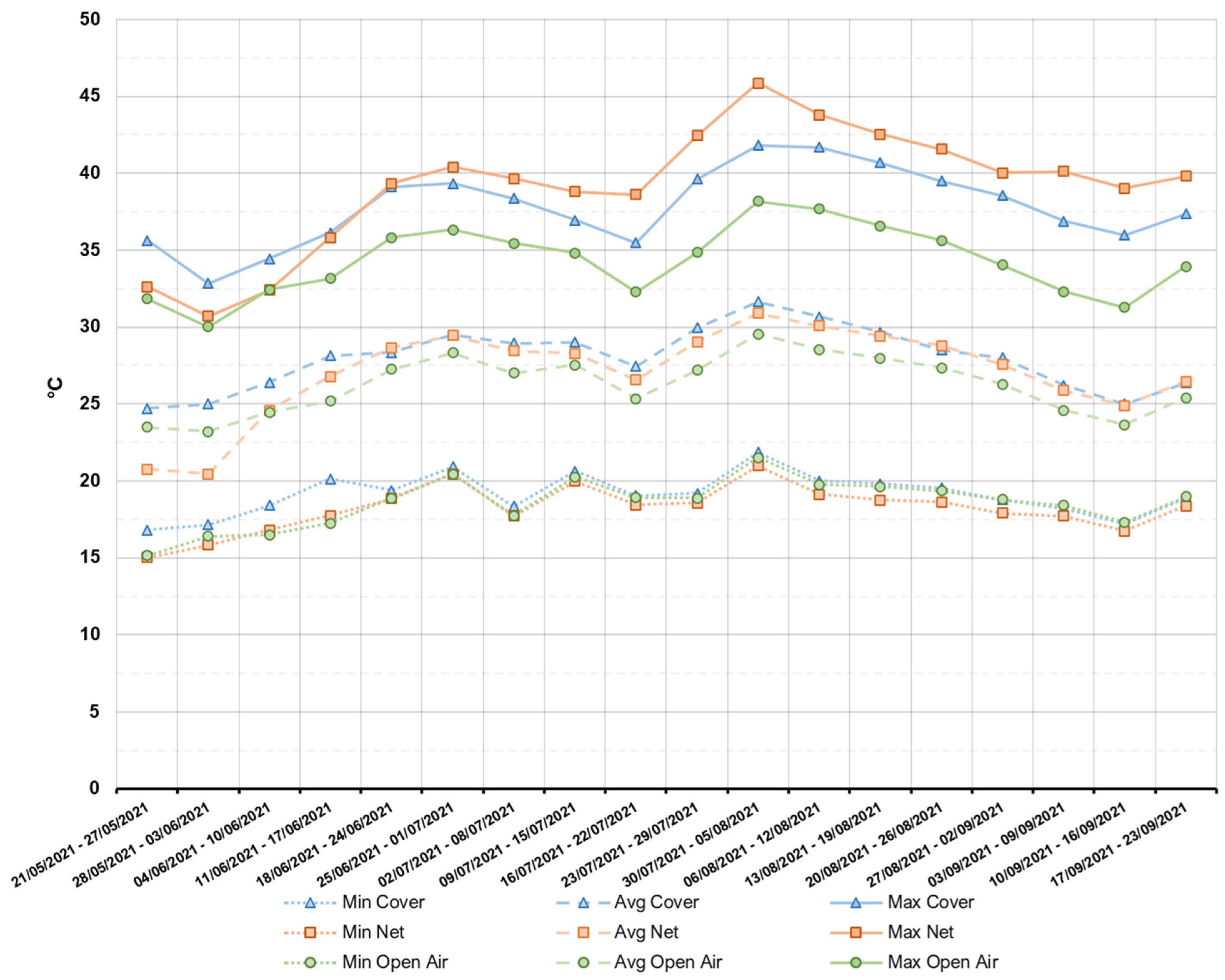
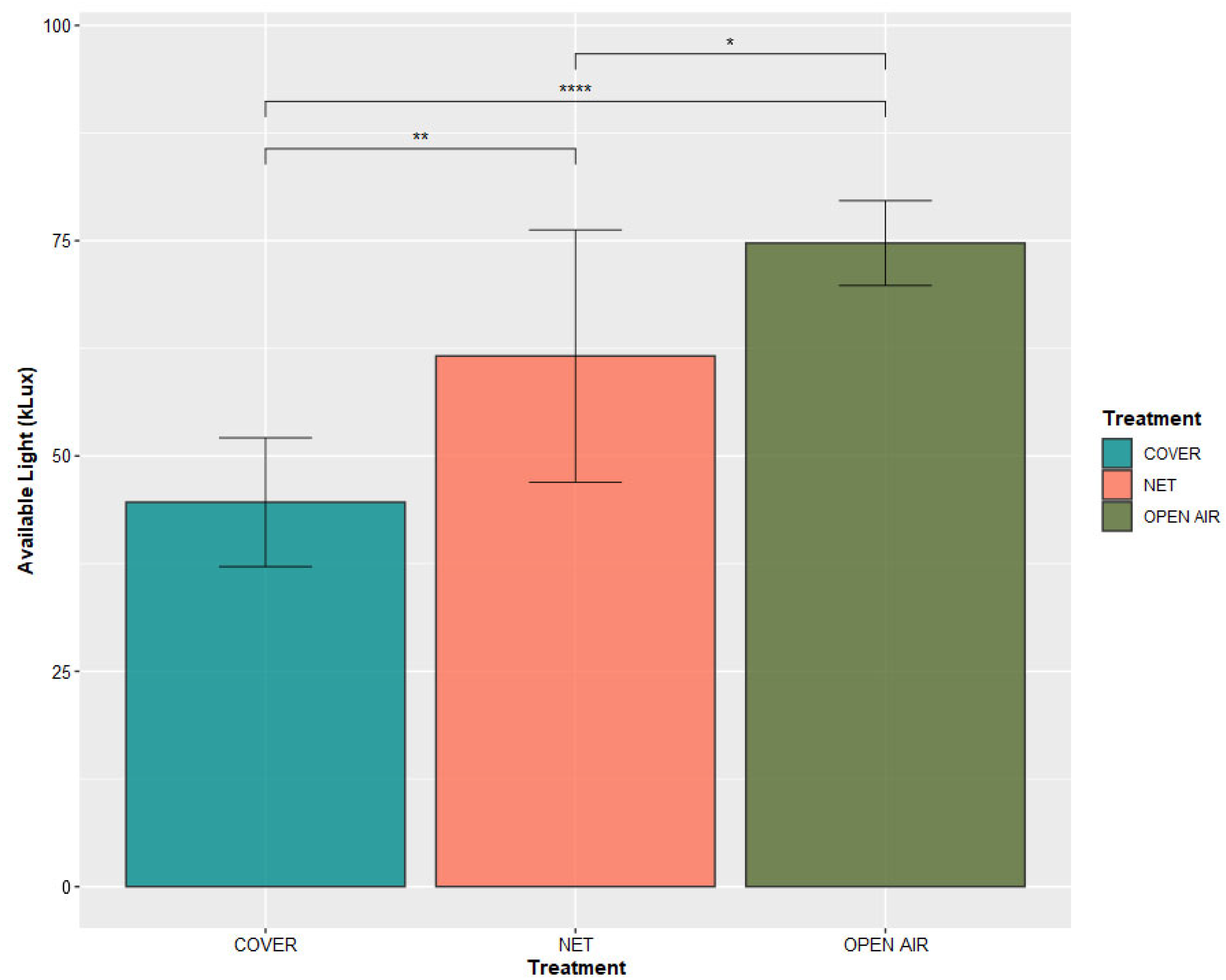

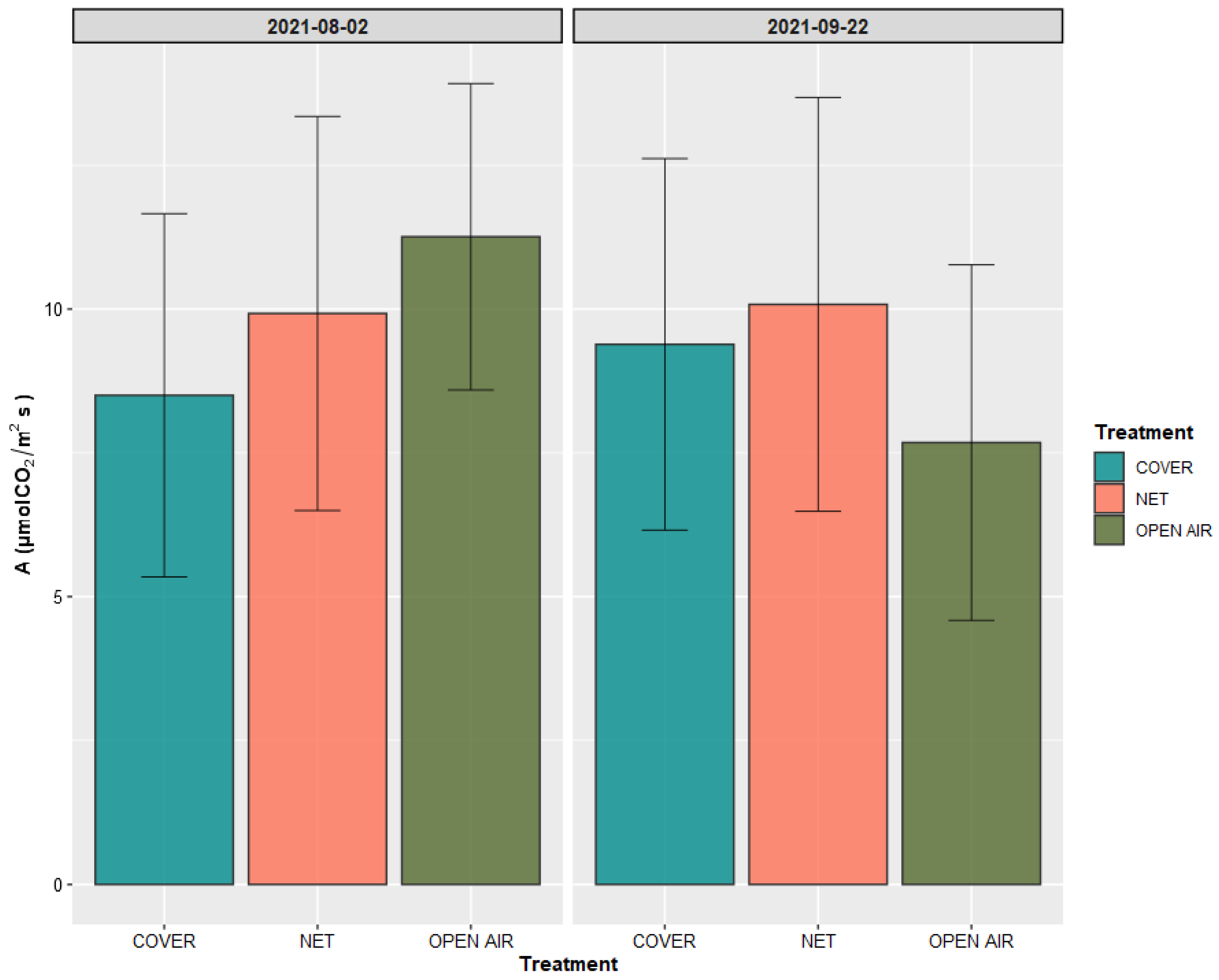
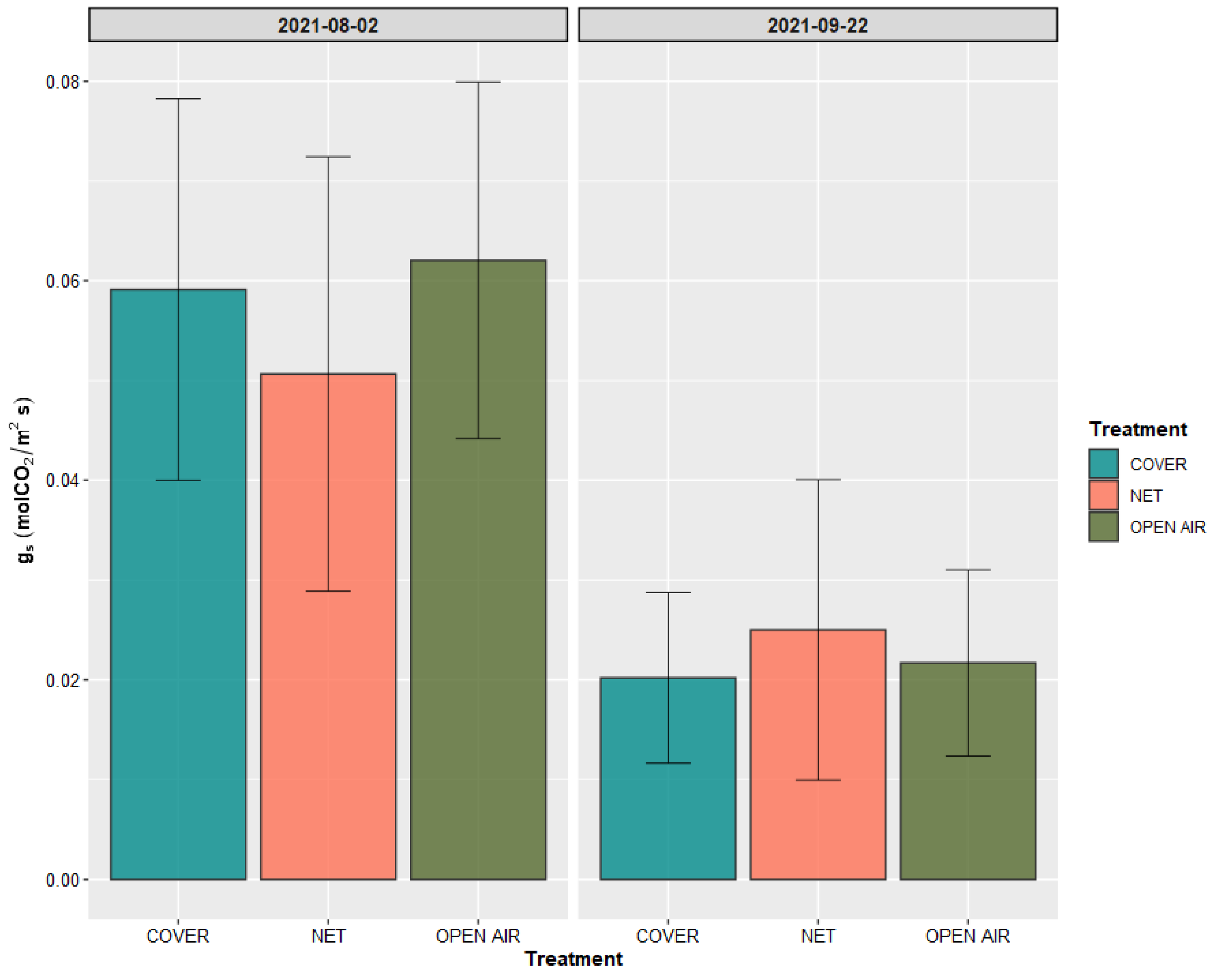
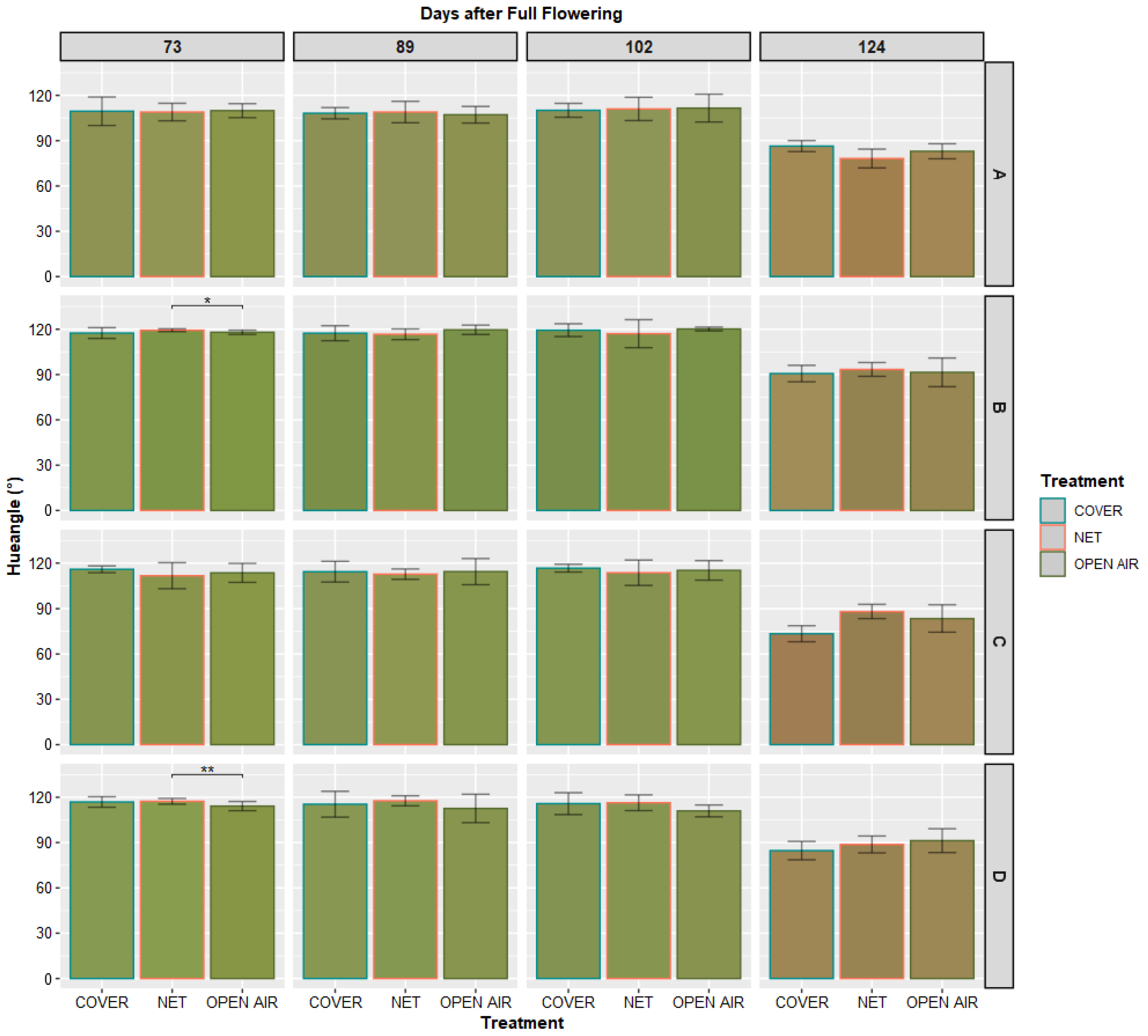




| Hue Angle (h°) | Chroma | |||||
|---|---|---|---|---|---|---|
| Treatment | Effect | d.f. | F | p | F | p |
| COVER | Spot | 3 | 1.46 | 0.262 | 1.55 | 0.241 |
| NET | Spot | 3 | 1.13 | 0.356 | 1.52 | 0.234 |
| OPEN AIR | Spot | 3 | 1.36 | 0.277 | 1.02 | 0.402 |
| Days After Full Flowering | ||||
|---|---|---|---|---|
| ΔE | 73 | 89 | 102 | 124 (Harvest) |
| COVER/OPEN AIR | 5.24 ± 1.65 | 2.66 ± 1.81 | 2.53 ± 1.12 | 1.70 ± 1.45 |
| NET/OPEN AIR | 3.07 ± 0.65 | 1.28 ± 2.74 | 1.86 ± 0.75 | 2.57 ± 3.89 |
Publisher’s Note: MDPI stays neutral with regard to jurisdictional claims in published maps and institutional affiliations. |
© 2022 by the authors. Licensee MDPI, Basel, Switzerland. This article is an open access article distributed under the terms and conditions of the Creative Commons Attribution (CC BY) license (https://creativecommons.org/licenses/by/4.0/).
Share and Cite
Scuderi, D.; Gugliuzza, G.; Di Salvo, G.; Priola, F.; Passafiume, R.; Farina, V. Shading Net and Partial Covering Plastic Film Do Not Affect Phenology, Photosynthetic Activity or Fruit Quality Traits of Kensington Pride Mango. Plants 2022, 11, 3510. https://doi.org/10.3390/plants11243510
Scuderi D, Gugliuzza G, Di Salvo G, Priola F, Passafiume R, Farina V. Shading Net and Partial Covering Plastic Film Do Not Affect Phenology, Photosynthetic Activity or Fruit Quality Traits of Kensington Pride Mango. Plants. 2022; 11(24):3510. https://doi.org/10.3390/plants11243510
Chicago/Turabian StyleScuderi, Dario, Giovanni Gugliuzza, Giuseppe Di Salvo, Federico Priola, Roberta Passafiume, and Vittorio Farina. 2022. "Shading Net and Partial Covering Plastic Film Do Not Affect Phenology, Photosynthetic Activity or Fruit Quality Traits of Kensington Pride Mango" Plants 11, no. 24: 3510. https://doi.org/10.3390/plants11243510
APA StyleScuderi, D., Gugliuzza, G., Di Salvo, G., Priola, F., Passafiume, R., & Farina, V. (2022). Shading Net and Partial Covering Plastic Film Do Not Affect Phenology, Photosynthetic Activity or Fruit Quality Traits of Kensington Pride Mango. Plants, 11(24), 3510. https://doi.org/10.3390/plants11243510











